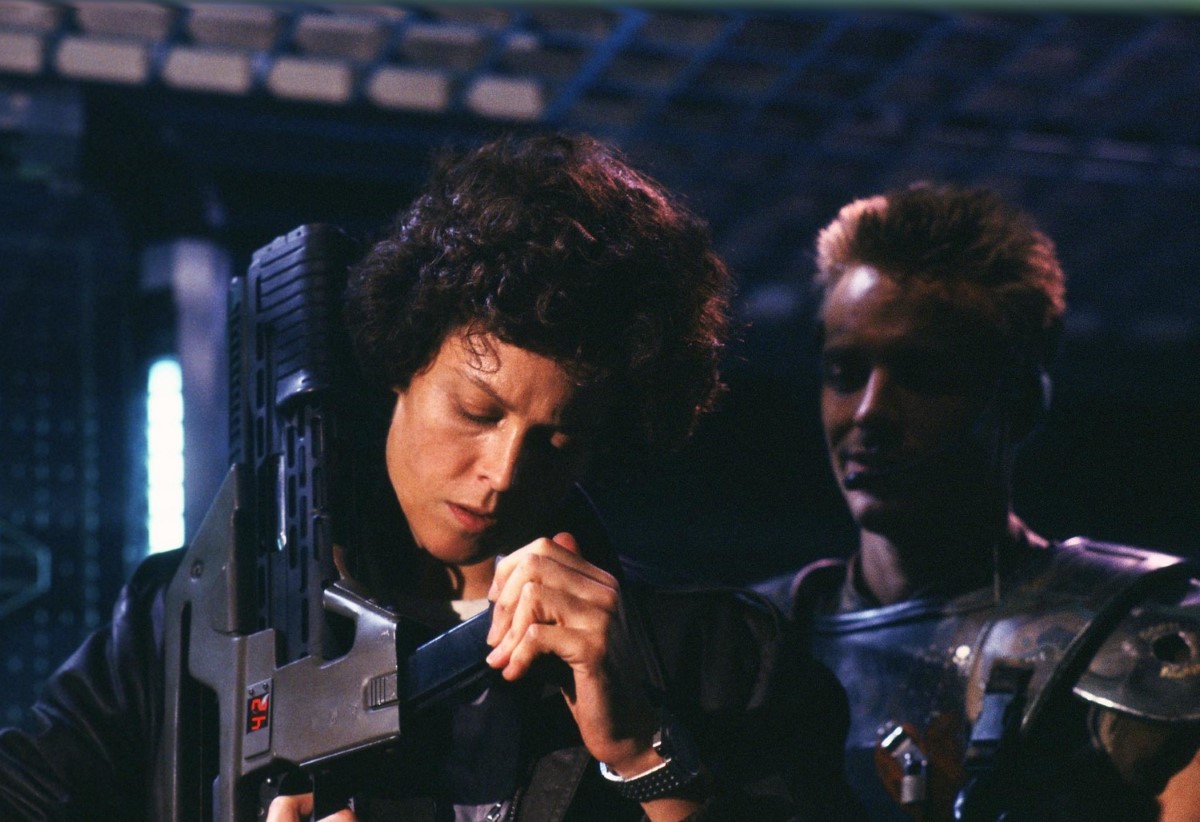by Pauline Kael
Aliens is a very big “Boo!” movie. Long (two hours and seventeen minutes) and visually repetitious, this sci-fi action-horror film is scaled to be an epic, and it’s certainly getting epic reviews. (“An authentic masterpiece!” “The scariest movie in the history of movies.” “The most satisfying science-fiction shocker ever.” And so on.) The writer-director James Cameron pumps up the familiar devices of the action and horror genres, and is acclaimed for imagination. (The praise suggests the Second Coming of John Carpenter.) An inflated example of formula gothic, this sequel to Ridley Scott’s 1979 Alien is more mechanical than the first film—more addicted to “advanced” weaponry and military hardware. The movie is really a combat film set in the future, in space; Cameron pits a platoon of U.S. Marines (ethnically assorted, of course) against a family of monsters. He does it in an energetic, systematic, relentless way, with an action director’s gusto. And though he writes bum dialogue, his images have a fair amount of graphic power; the movie has the look of a comic book for adults, and it achieves a fairy-tale horror when the queen monster looms up waving her tentacles, opening her metal jaws, and gnashing her switchblade teeth. She represents extraterrestrial primal evil, which might seem to be enough menace for one movie, but, to raise the ante, Cameron throws in the threat of a nuclear explosion.
As Warrant Officer Ripley, the only human survivor of the spaceship Nostromo, which voyaged forth in the earlier film, Sigourney Weaver is the one person who has looked into the face of evil and lived, but she’s stricken with recurrent nightmares and the cold shakes. Weaver uses the trauma of this experience as the basis for creating what passes here for a character. Weaver’s Ripley is different from other people: she’s more intense; an angry, high-strung loner, she has been through too much horror to have any patience with small talk—she gets right to the point of things. Made consultant to a new expedition to the monsters’ planet— its mission is to find out what happened to the human colonizers who have gone there—she sees that those in charge are lightweights, brushes them aside, and takes command. With her great cheekbones, her marvellous physique, and her lightness of movement, Weaver seems to take over by natural authority and her strength as an actress. Her surprisingly small, tense mouth holds all the suspense in the story. She’s concentrating on the problems at hand when nobody else is. Weaver gives the movie a presence; without her it’s a B picture that lacks the subplots and corny characters that can make B pictures amusing.
Cameron does include some B gimmicks, such as showing a crew member (Michael Biehn) training Weaver in the use of a huge, heavy gun and taking pride in her prowess with it. (This is the closest that the movie comes to romance.) And Cameron plays a few B games, such as having a Hispanic woman bodybuilder (Jenette Goldstein) among the roughhousing, muscular fighting Marines. (She wears a red headband, like a guerrilla.) But except for Weaver the film is short on inventive acting, and I would have thought that Cameron (who directed the Schwarzenegger picture The Terminator, and wrote the script for Rambo: First Blood Part II before Stallone reshaped it) would be too embarrassed to toss in the wraithlike, fey little girl, Newt (Carrie Henn), the survivor of the human colony on the deadly planet. Cameron actually gives Newt a forlorn remnant of a doll, so that it can float in brackish liquid when she has been captured. She is the kind of child you meet only in movies, where they’re used to give plots some sentimental propulsion. Newt is out there in space to arouse Ripley’s maternal instinct. That way Ripley’s final confrontation with the toothy monster will be the Battle of the Big Mamas.
Alien, with its horrible mutating creature (you never knew what form it would take), made you dread the scenes to come; it tied your innards in a knot. Aliens isn’t that scary. There’s an awful lot of claustrophobic blue-green dankness in the outpost that the colonists lived in, and when we see a tantalizing image, such as the Marines trying to find their way through a cavernous structure that looks like a sleeping giant’s rib cage, the scene just leads to the use of battle weapons. Cameron is not a man for magic; he’s more confident when he’s showing off an armored personnel carrier or a cargo-handling machine with clumping feet. When Sigourney Weaver loads up with an arsenal of flame-shooting equipment and goes forth to fight the queen, she’s no more than a smart Rambo. This movie has clumping feet.
The New Yorker, August 11, 1986





